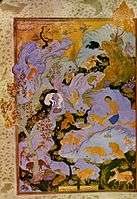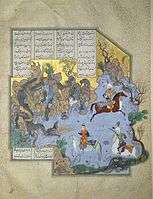Aqa Mirak

Aqa Mirak (fl. 1520 – Qazvin, 1576) was a Persian illustrator and painter.
Life
Aqa Mirak was a painter, purveyor and companion to the Safavid shah Tahmasp I and was well known in contemporary circles. Initially living in Tabriz, he traveled and lived in Mashhad between 1555 and 1565, and Qazvin from 1565 until his death.[1]
Works
The contemporary chronicler Dust Muhammad mentioned that Aqa Mirak along with Mir Musavvir did wall paintings for Prince Sam Mirza's palace in Tabriz and illustrations for royal manuscripts including the Shahnameh of Shah Tahmasp, a superb copy of Firdawsi's Shahnameh ('Book of kings') and Nizami's Khamsa ('Five poems'). Qazi Ahmad wrote that Aqa Mirak "had no peer in artistic design and was an incomparable painter, very clever, enamoured of his art, a bon vivant, an intimate [of the Shah] and a sage". A manuscript of the Khamsa done between 1539 and 1543 has four illustrations bearing attributions to Aqa Mirak. Dickson and Welch have attributed other paintings to Aqa Mirak in the monumental copy of the Shahnama made for Tahmasp, and have used these attributions to define four periods in the artist's life.[1]
Style
Works ascribed to a youthful period in the 1520s have tautly composed landscapes inhabited by a few large-scale figures. A transitional period in the early 1530s was followed by mature works produced from the late 1530s to c. 1555, in which the compositions are more complex and the coloring more subtle. In the view of Dickson and Welch, at the end of his life the artist returned to his youthful style in two paintings for Ibrahim Mirza's copy of Jami's Haft Awrang ('Seven thrones') produced between 1556 and 1565.[1]
Gallery
-

Majnun in the desert from Layla and Majnun (1543-44)
-
-

Faridun in the guise of a dragon test his sons, from the Shahnameh of Shah Tahmasp, attributed to Aqa Mirak (c. 1525-35)
References
- 1 2 3 "Aqa Mirak Brief Bio". Retrieved 2013-05-06.
| Wikimedia Commons has media related to Aga Mirek. |